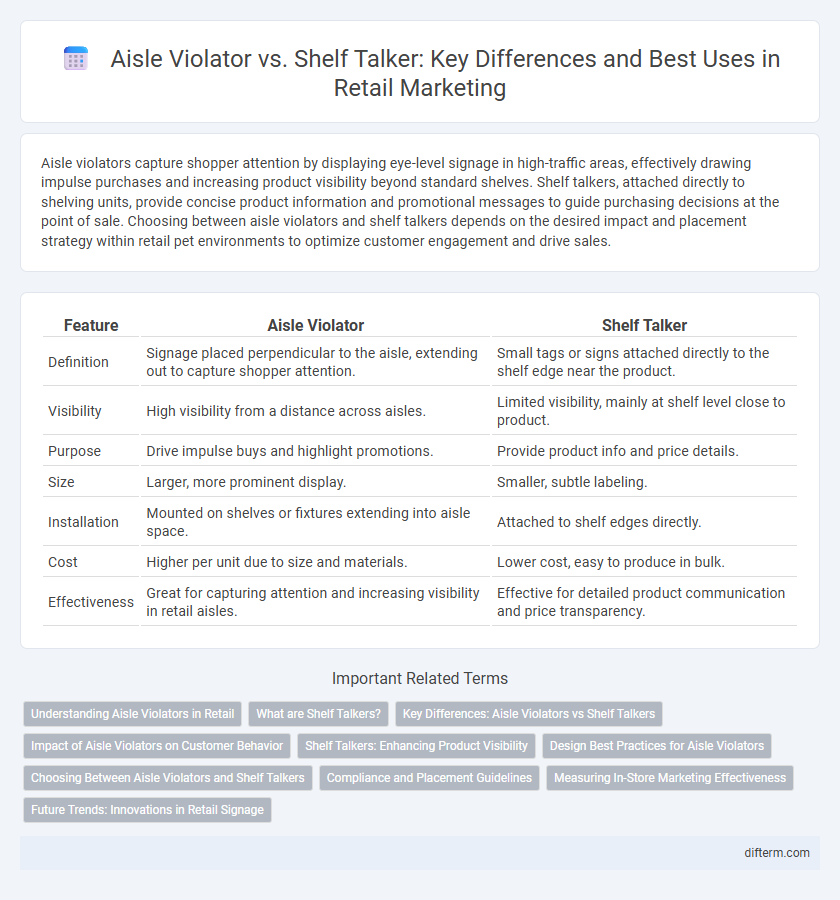Aisle violators capture shopper attention by displaying eye-level signage in high-traffic areas, effectively drawing impulse purchases and increasing product visibility beyond standard shelves. Shelf talkers, attached directly to shelving units, provide concise product information and promotional messages to guide purchasing decisions at the point of sale. Choosing between aisle violators and shelf talkers depends on the desired impact and placement strategy within retail pet environments to optimize customer engagement and drive sales.
Table of Comparison
| Feature | Aisle Violator | Shelf Talker |
|---|---|---|
| Definition | Signage placed perpendicular to the aisle, extending out to capture shopper attention. | Small tags or signs attached directly to the shelf edge near the product. |
| Visibility | High visibility from a distance across aisles. | Limited visibility, mainly at shelf level close to product. |
| Purpose | Drive impulse buys and highlight promotions. | Provide product info and price details. |
| Size | Larger, more prominent display. | Smaller, subtle labeling. |
| Installation | Mounted on shelves or fixtures extending into aisle space. | Attached to shelf edges directly. |
| Cost | Higher per unit due to size and materials. | Lower cost, easy to produce in bulk. |
| Effectiveness | Great for capturing attention and increasing visibility in retail aisles. | Effective for detailed product communication and price transparency. |
Understanding Aisle Violators in Retail
Aisle violators in retail refer to unauthorized product displays or obstructions placed in store aisles that can disrupt customer flow and reduce shopping convenience. Unlike shelf talkers, which are small signage attached directly to product shelves to provide information or promotions, aisle violators often create clutter, hinder navigation, and pose safety risks. Effective management of aisle violators improves store layout, enhances customer experience, and supports compliance with retail safety standards.
What are Shelf Talkers?
Shelf talkers are small, strategically placed signs attached directly to store shelves, designed to capture shoppers' attention by providing concise product information, promotional offers, or pricing details. These marketing tools enhance product visibility and influence purchasing decisions at the point of sale by delivering targeted messages right where consumers browse. Retailers use shelf talkers to highlight key product features, new arrivals, or special discounts, driving engagement and boosting sales efficiently within limited shelf space.
Key Differences: Aisle Violators vs Shelf Talkers
Aisle violators are large, eye-catching displays that extend into the shopping aisle, designed to capture customer attention through prominent placement and bold messaging. Shelf talkers, in contrast, are smaller, shelf-mounted signs that provide detailed product information and promotional details directly alongside the merchandise. The key difference lies in their size and placement: aisle violators disrupt aisle space to maximize visibility, while shelf talkers enhance the shopper's decision-making process with targeted, close-proximity communication.
Impact of Aisle Violators on Customer Behavior
Aisle violators, prominent signage placed in the middle of retail aisles, significantly capture shopper attention by interrupting the natural flow, leading to increased product discovery and impulse purchases. Their strategic positioning enhances brand visibility and encourages shoppers to explore promotions they might otherwise overlook, directly influencing customer engagement and dwell time. Compared to shelf talkers, which provide product-specific information at eye level, aisle violators drive higher traffic by physically obstructing the aisle and compelling shoppers to pause and interact with the display.
Shelf Talkers: Enhancing Product Visibility
Shelf talkers enhance product visibility by providing targeted information directly at the point of sale, increasing customer engagement and boosting impulse buys. Unlike aisle violators, shelf talkers are strategically placed on shelves, creating a non-intrusive yet effective way to highlight promotions, features, or benefits of specific products. Their customizable design allows retailers to capture shopper attention, improve brand recall, and drive higher sales conversion rates in competitive retail environments.
Design Best Practices for Aisle Violators
Aisle violators should be designed with bold, contrasting colors and clear, concise messaging to capture shopper attention quickly in high-traffic areas. Incorporating eye-level placement and readable fonts ensures maximum visibility and effective communication of promotions. Durable materials resistant to wear and tear maintain professional appearance and extend display lifespan in retail environments.
Choosing Between Aisle Violators and Shelf Talkers
Choosing between aisle violators and shelf talkers hinges on the desired visibility and customer engagement level within retail spaces. Aisle violators extend into the aisle, capturing attention with bold messaging and are ideal for promoting special offers or new products that require high visibility. Shelf talkers, being smaller and attached directly to shelves, provide detailed product information and benefits, making them suitable for influencing purchase decisions at the point of sale.
Compliance and Placement Guidelines
Aisle violators must comply with retail standards by being positioned at aisle endcaps or within designated zones to avoid obstructing traffic flow and ensuring clear sightlines. Shelf talkers require strict adherence to shelf edge placement guidelines, maintaining height and size limits to prevent blocking product visibility or violating planogram instructions. Proper compliance with placement rules enhances store navigation, supports retailer merchandising strategies, and maximizes promotional impact.
Measuring In-Store Marketing Effectiveness
Measuring in-store marketing effectiveness requires analyzing the impact of aisle violators and shelf talkers on consumer behavior and sales metrics. Aisle violators, positioned strategically in high-traffic areas, often drive higher impulse purchases and brand visibility, while shelf talkers provide targeted product information directly at the point of sale, influencing shopper decision-making. Retailers leverage sales lift data, shopper engagement rates, and dwell time to quantify the performance differences between aisle violators and shelf talkers in boosting conversion and average transaction value.
Future Trends: Innovations in Retail Signage
Future trends in retail signage highlight the evolution of aisle violators and shelf talkers through digital integration and personalized customer engagement. Smart aisle violators leverage sensors and AI to display dynamic promotions that adapt to shopper behavior in real-time. Shelf talkers are increasingly adopting augmented reality and interactive displays to provide immersive product information and enhance the in-store shopping experience.
Aisle Violator vs Shelf Talker Infographic

 difterm.com
difterm.com